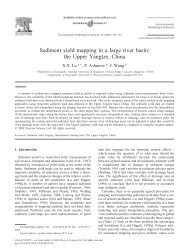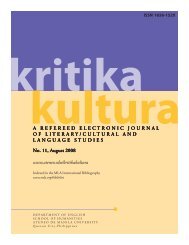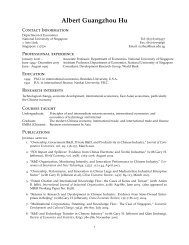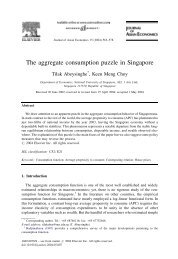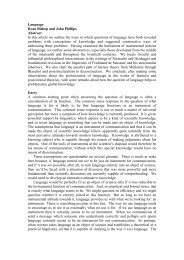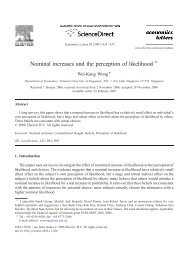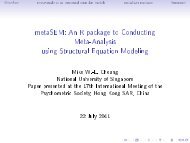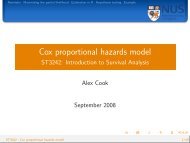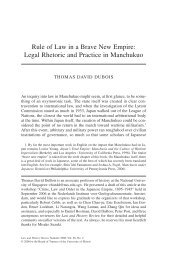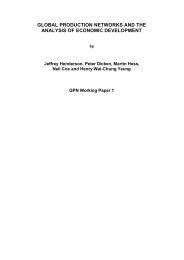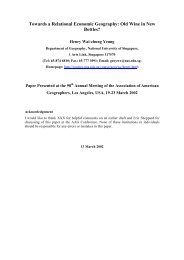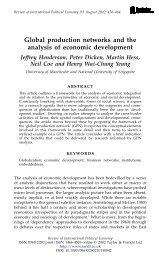Researching Hybridity in Social and Economic ... - NUS Home
Researching Hybridity in Social and Economic ... - NUS Home
Researching Hybridity in Social and Economic ... - NUS Home
Create successful ePaper yourself
Turn your PDF publications into a flip-book with our unique Google optimized e-Paper software.
discussion of the socio-spatial attributes of these actors does not <strong>in</strong>tend to imply that these<br />
actors must be all powerful people <strong>and</strong>/or <strong>in</strong>stitutions. Instead, I believe that power is a<br />
relational construct <strong>in</strong> the sense that it “is not some ‘th<strong>in</strong>g’ that moves, but an effect that is<br />
mediated, <strong>and</strong> such effects may mutate through relations of successive or simultaneous reach”<br />
(Allen, 2003: 37). An actor’s power is not a given attribute because its efficacy can only be<br />
known when it is realized (Yeung, 2004b). So we th<strong>in</strong>k of a person, a firm or an <strong>in</strong>stitution as<br />
powerful or hav<strong>in</strong>g power when we know of prior outcomes aris<strong>in</strong>g from the structures of<br />
relations <strong>in</strong> which this person, firm or <strong>in</strong>stitution is embedded. This person, firm or <strong>in</strong>stitution<br />
can be deemed to possess a capacity to act with<strong>in</strong> those structures of relations. Its power is<br />
dependent on the fact that this capacity is exercised eventually <strong>and</strong> successfully. For example,<br />
a patriarch <strong>in</strong> the family bus<strong>in</strong>ess may not be as powerful as we imag<strong>in</strong>e if there is a<br />
significant contestation of power among the sibl<strong>in</strong>gs outside the control of this patriarch.<br />
Similarly, a seem<strong>in</strong>gly <strong>in</strong>significant <strong>and</strong> low rank<strong>in</strong>g local official <strong>in</strong> Indonesia (i.e. an<br />
<strong>in</strong>termediary), through his/her sheer lack of cooperation <strong>and</strong> support of a major <strong>in</strong>frastructural<br />
development project, may create such a havoc for a Ch<strong>in</strong>ese bus<strong>in</strong>ess firm that its bankruptcy<br />
becomes imm<strong>in</strong>ent. Track<strong>in</strong>g down actor networks <strong>in</strong> Ch<strong>in</strong>ese capitalism is therefore both<br />
theoretically <strong>and</strong> methodologically challeng<strong>in</strong>g.<br />
Given actor network theory’s ontology <strong>and</strong> methodological framework, actor networks<br />
are def<strong>in</strong>ed as “the cha<strong>in</strong>s which give rise to natural <strong>and</strong> social realities, realities which can<br />
only be understood as stabilised sets of relations which allow the construction of centres <strong>and</strong><br />
peripheries, <strong>in</strong>sides <strong>and</strong> outsides, humans <strong>and</strong> nonhumans, nature <strong>and</strong> society, <strong>and</strong> so on”<br />
(Murdoch, 1997a: 743). In short, an “actor network is simultaneously an actor whose activity<br />
is network<strong>in</strong>g heterogeneous elements” of humans <strong>and</strong> non-humans “<strong>and</strong> a network that is<br />
able to redef<strong>in</strong>e <strong>and</strong> transform what it is made of” (Callon, 1987: 93, cited <strong>in</strong> B<strong>in</strong>gham, 1996:<br />
647). Certa<strong>in</strong>ly the emphasis on relational practices highlighted <strong>in</strong> actor network theory is<br />
21



